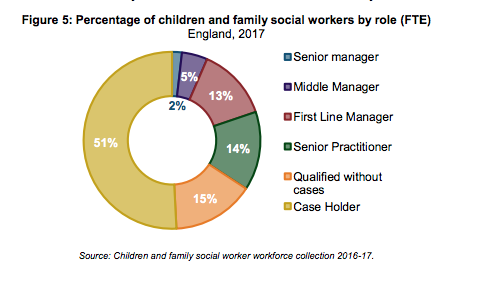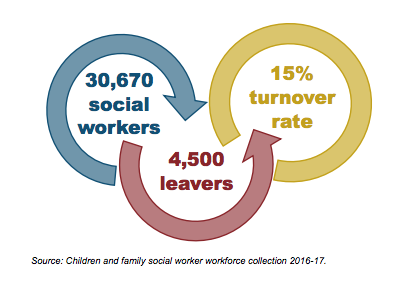“Children and family social work has always been a challenging and busy field, however after 20 years in it I feel I can say that I have never seen things this bad.”
Kerie Anne is a UNISON member living in London, and her view is shared by many social workers who speak to UNISON – they frequently tell us that social workers have more work and are under more pressure than ever.
But how to quantify this? Every year the government’s Department for Education publishes data on the children and families social work workforce, which includes data on caseloads. Unfortunately, we’ve found it doesn’t quite give an accurate picture.
Now, this data is labelled ‘experimental’, which means the government knows it may have problems. Let’s look into it.
According to the data, the average number of cases per case-holding social worker is 17.8. The local authority with the lowest average caseload is Kingston upon Thames with 10.2, and the highest is Staffordshire, with 26.4.
However, there are a couple of problems with this data.
Kerie Anne, who spoke to us in her capacity as a union rep, has worked as a social worker in an inner-London borough for many years. She explained why the data on average caseload doesn’t reflect a true picture.
The first problem is that the report is not clear on whether a case means one child or one family. Kerie Anne says, “If it is counting one family as one case, this can mask the actual volume of work – for example one family might have three children, some at home needing support and some in care, needing legal work and everything that goes with that.”

The second problem with the data is that there are different types of children’s social workers. Some boroughs have social workers who see a child all the way through the system, but many boroughs split up the process, so that one type of social worker will be in an intake team, another may be an adoption specialist, and another may be in a fostering team.
“The nature of work amongst the different teams in children’s services is so different that what is an acceptable caseload in terms of numbers of children or numbers of families changes between the areas of work,” Kerie Anne said. “It’s like comparing apples and oranges.”
Rebecca is a Children and family senior social worker who works in family support and child protection. She has been a social worker for 3.5 years and she says that it is difficult to measure their workload in terms of cases: “Often it is the complexity of the cases that can be draining. If you have 17 children but the majority are child protection cases or are in pre-court or court proceedings then you are still quite overwhelmed.”
We contacted the authors of the data to find out if they planned to break down caseload data further in future reports, but they didn’t respond.

While the government is aware that the data collected isn’t perfect (which is why it’s labelled experimental), the accounts of UNISON social workers suggest more needs to be done to assess just exactly what social workers have on their plate, because over-worked social workers aren’t good for anyone.
As Rebecca said, if social workers have too much work, “you are just fire-fighting rather than understanding the issues families have and being able to provide the right support to prevent things from happening again.”
The article Social workers are overworked but the data is hiding it first appeared on the UNISON National site.
from RSSMix.com Mix ID 8239598 https://www.unison.org.uk/news/article/2018/07/social-workers-overworked-data-hiding/
via IFTTT
source https://childrensplayareadesigns.tumblr.com/post/175611954987
No comments:
Post a Comment